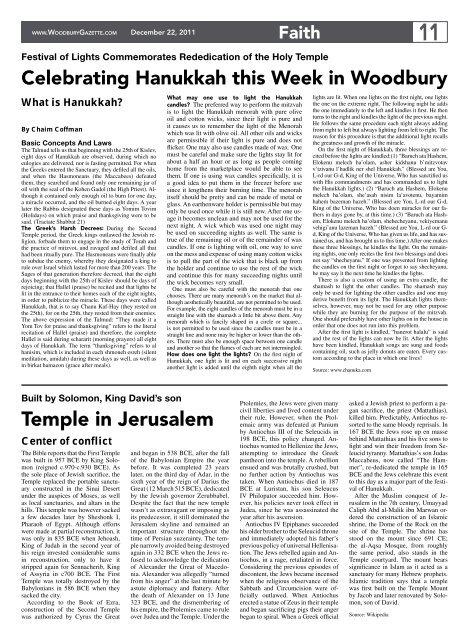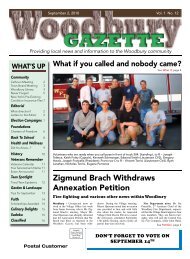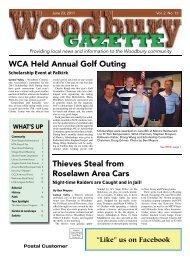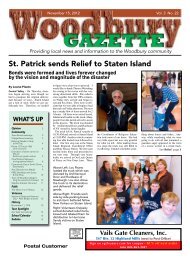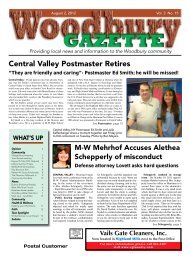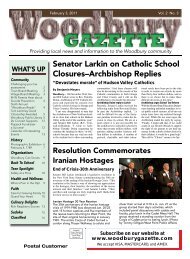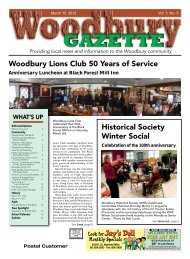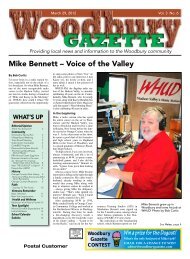view the December 22, 2011 issue as a PDF. - Woodbury Gazette
view the December 22, 2011 issue as a PDF. - Woodbury Gazette
view the December 22, 2011 issue as a PDF. - Woodbury Gazette
Create successful ePaper yourself
Turn your PDF publications into a flip-book with our unique Google optimized e-Paper software.
WWW.WOODBURYGAZETTE.COM <strong>December</strong> <strong>22</strong>, <strong>2011</strong>Faith11Festival of Lights Commemorates Rededication of <strong>the</strong> Holy TempleCelebrating Hanukkah this Week in <strong>Woodbury</strong>What is Hanukkah?By Chaim CoffmanB<strong>as</strong>ic Concepts And LawsThe Talmud tells us that beginning with <strong>the</strong> 25th of Kislev,eight days of Hanukkah are observed, during which noeulogies are delivered, nor is f<strong>as</strong>ting permitted. For when<strong>the</strong> Greeks entered <strong>the</strong> Sanctuary, <strong>the</strong>y defiled all <strong>the</strong> oils,and when <strong>the</strong> H<strong>as</strong>moneans (<strong>the</strong> Maccabees) defeated<strong>the</strong>m, <strong>the</strong>y searched and found only one remaining jar ofoil with <strong>the</strong> seal of <strong>the</strong> Kohen Gadol (<strong>the</strong> High Priest). Althoughit contained only enough oil to burn for one day,a miracle occurred, and <strong>the</strong> oil burned eight days. A yearlater <strong>the</strong> Rabbis designated <strong>the</strong>se days <strong>as</strong> Yomim Tovim(Holidays) on which praise and thanksgiving were to besaid. (Tractate Shabbat 21)The Greek’s Harsh Decrees: During <strong>the</strong> SecondTemple period, <strong>the</strong> Greek kings outlawed <strong>the</strong> Jewish religion,forbade <strong>the</strong>m to engage in <strong>the</strong> study of Torah and<strong>the</strong> practice of mitzvot, and ravaged and defiled all thathad been ritually pure. The H<strong>as</strong>moneans were finally ableto subdue <strong>the</strong> enemy, whereby <strong>the</strong>y designated a king torule over Israel which l<strong>as</strong>ted for more than 200 years. TheSages of that generation <strong>the</strong>refore decreed, that <strong>the</strong> eightdays beginning with <strong>the</strong> 25th of Kislev should be days ofrejoicing; that Hallel (praise) be recited and that lights belit in <strong>the</strong> entrance to <strong>the</strong>ir homes each of <strong>the</strong> eight nights,in order to publicize <strong>the</strong> miracle. These days were calledHanukkah, that is to say Chanu Kaf-Hay (<strong>the</strong>y rested on<strong>the</strong> 25th), for on <strong>the</strong> 25th, <strong>the</strong>y rested from <strong>the</strong>ir enemies.The above expression of <strong>the</strong> Talmud: “They made it aYom Tov for praise and thanksgiving” refers to <strong>the</strong> literalrecitation of Hallel (praise) and <strong>the</strong>refore, <strong>the</strong> completeHallel is said during schararit (morning prayers) all eightdays of Hanukkah. The term “thanksgiving” refers to alhanisim, which is included in each shmoneh esreh (silentmeditation, amidah) during <strong>the</strong>se days <strong>as</strong> well, <strong>as</strong> well <strong>as</strong>in birkat hamazon (grace after meals).What may one use to light <strong>the</strong> Hanukkahcandles? The preferred way to perform <strong>the</strong> mitzvahis to light <strong>the</strong> Hanukkah menorah with pure oliveoil and cotton wicks, since <strong>the</strong>ir light is pure andit causes us to remember <strong>the</strong> light of <strong>the</strong> Menorahwhich w<strong>as</strong> lit with olive oil. All o<strong>the</strong>r oils and wicksare permissible if <strong>the</strong>ir light is pure and does notflicker. One may also use candles made of wax. Onemust be careful and make sure <strong>the</strong> lights stay lit forabout a half an hour or <strong>as</strong> long <strong>as</strong> people cominghome from <strong>the</strong> marketplace would be able to see<strong>the</strong>m. If one is using wax candles specifically, it isa good idea to put <strong>the</strong>m in <strong>the</strong> freezer before usesince it leng<strong>the</strong>ns <strong>the</strong>ir burning time. The menorahitself should be pretty and can be made of metal orgl<strong>as</strong>s. An ear<strong>the</strong>nware holder is permissible but mayonly be used once while it is still new. After one usageit becomes unclean and may not be used for <strong>the</strong>next night. A wick which w<strong>as</strong> used one night maybe used on succeeding nights <strong>as</strong> well. The same istrue of <strong>the</strong> remaining oil or of <strong>the</strong> remainder of waxcandles. If one is lighting with oil, one way to saveon <strong>the</strong> mess and expense of using many cotton wicksis to pull <strong>the</strong> part of <strong>the</strong> wick that is black up from<strong>the</strong> holder and continue to use <strong>the</strong> rest of <strong>the</strong> wickand continue this for many succeeding nights until<strong>the</strong> wick becomes very small.One must also be careful with <strong>the</strong> menorah that onechooses. There are many menorah’s on <strong>the</strong> market that althoughaes<strong>the</strong>tically beautiful, are not permitted to be used.For example, <strong>the</strong> eight candles of <strong>the</strong> menorah must be in <strong>as</strong>traight line with <strong>the</strong> sham<strong>as</strong>h a little bit above <strong>the</strong>m. Anymenorah which is fancily shaped in a circle or square...is not permitted to be used since <strong>the</strong> candles must be in <strong>as</strong>traight line and none may be higher or lower than <strong>the</strong> o<strong>the</strong>rs.There must also be enough space between one candleand ano<strong>the</strong>r so that <strong>the</strong> flames of each are not intermingled.How does one light <strong>the</strong> lights? On <strong>the</strong> first night ofHanukkah, one light is lit and on each successive nightano<strong>the</strong>r light is added until <strong>the</strong> eighth night when all <strong>the</strong>lights are lit. When one lights on <strong>the</strong> first night, one lights<strong>the</strong> one on <strong>the</strong> extreme right. The following night he adds<strong>the</strong> one immediately to <strong>the</strong> left and kindles it first. He <strong>the</strong>nturns to <strong>the</strong> right and kindles <strong>the</strong> light of <strong>the</strong> previous night.He follows <strong>the</strong> same procedure each night always addingfrom right to left but always lighting from left to right. There<strong>as</strong>on for this procedure is that <strong>the</strong> additional light recalls<strong>the</strong> greatness and growth of <strong>the</strong> miracle.On <strong>the</strong> first night of Hanukkah, three blessings are recitedbefore <strong>the</strong> lights are kindled:(1) “Baruch ata H<strong>as</strong>hem,Elokenu melech ha’olam, <strong>as</strong>her kidshanu b’mitzvotavv’tzivanu l’hadlik ner shel Hanukkah.” (Blessed are You,L-rd our G-d, King of <strong>the</strong> Universe, Who h<strong>as</strong> sanctified uswith His commandments and h<strong>as</strong> commanded us to light<strong>the</strong> Hanukkah lights.) (2) “Baruch ata H<strong>as</strong>hem, Elokenumelech ha’olam, she’<strong>as</strong>ah nisim la’avotenu, bayamimhahem bazeman hazeh.” (Blessed are You, L-rd our G-d,King of <strong>the</strong> Universe, Who h<strong>as</strong> doen miracles for our fa<strong>the</strong>rsin days gone by, at this time.) (3) “Baruch ata H<strong>as</strong>hem,Elokenu melech ha’olam, shehecheyanu, vekiyemanuvehigi’anu lazeman hazeh.” (Blessed are You, L-rd our G-d, King of <strong>the</strong> Universe, Who h<strong>as</strong> given us life, and h<strong>as</strong> sustainedus, and h<strong>as</strong> brought us to this time.) After one makes<strong>the</strong>se three blessings, he kindles <strong>the</strong> light. On <strong>the</strong> remainingnights, one only recites <strong>the</strong> first two blessings and doesnot say “shecheyanu.” If one w<strong>as</strong> prevented from lighting<strong>the</strong> candles on <strong>the</strong> first night or forgot to say shecheyanu,he may say it <strong>the</strong> next time he kindles <strong>the</strong> lights.There is also a custom of using an extra candle, <strong>the</strong>sham<strong>as</strong>h to light <strong>the</strong> o<strong>the</strong>r candles. The sham<strong>as</strong>h mayonly be used for lighting <strong>the</strong> o<strong>the</strong>r candles and one mayderive benefit from its light. The Hanukkah lights <strong>the</strong>mselves,however, may not be used for any o<strong>the</strong>r purposewhile <strong>the</strong>y are burning for <strong>the</strong> purpose of <strong>the</strong> mitzvah.One should preferably have o<strong>the</strong>r lights on in <strong>the</strong> house inorder that one does not run into this problem.After <strong>the</strong> first light is kindled, “hanerot halalu” is saidand <strong>the</strong> rest of <strong>the</strong> lights can now be lit. After <strong>the</strong> lightshave been kindled, Hanukkah songs are sung and foodscontaining oil, such <strong>as</strong> jelly donuts are eaten. Every customaccording to <strong>the</strong> place in which one lives!Source: www.chanuka.comBuilt by Solomon, King David’s sonTemple in JerusalemCenter of conflictThe Bible reports that <strong>the</strong> First Templew<strong>as</strong> built in 957 BCE by King Solomon(reigned c.970-c.930 BCE). As<strong>the</strong> sole place of Jewish sacrifice, <strong>the</strong>Temple replaced <strong>the</strong> portable sanctuaryconstructed in <strong>the</strong> Sinai Desertunder <strong>the</strong> auspices of Moses, <strong>as</strong> well<strong>as</strong> local sanctuaries, and altars in <strong>the</strong>hills. This temple w<strong>as</strong> however sackeda few decades later by Sheshonk I,Pharaoh of Egypt. Although effortswere made at partial reconstruction, itw<strong>as</strong> only in 835 BCE when Jeho<strong>as</strong>h,King of Judah in <strong>the</strong> second year ofhis reign invested considerable sumsin reconstruction, only to have itstripped again for Sennacherib, Kingof Assyria in c700 BCE. The FirstTemple w<strong>as</strong> totally destroyed by <strong>the</strong>Babylonians in 586 BCE when <strong>the</strong>ysacked <strong>the</strong> city.According to <strong>the</strong> Book of Ezra,construction of <strong>the</strong> Second Templew<strong>as</strong> authorized by Cyrus <strong>the</strong> Greatand began in 538 BCE, after <strong>the</strong> fallof <strong>the</strong> Babylonian Empire <strong>the</strong> yearbefore. It w<strong>as</strong> completed 23 yearslater, on <strong>the</strong> third day of Adar, in <strong>the</strong>sixth year of <strong>the</strong> reign of Darius <strong>the</strong>Great (12 March 515 BCE), dedicatedby <strong>the</strong> Jewish governor Zerubbabel.Despite <strong>the</strong> fact that <strong>the</strong> new templew<strong>as</strong>n’t <strong>as</strong> extravagant or imposing <strong>as</strong>its predecessor, it still dominated <strong>the</strong>Jerusalem skyline and remained animportant structure throughout <strong>the</strong>time of Persian suzerainty. The templenarrowly avoided being destroyedagain in 332 BCE when <strong>the</strong> Jews refusedto acknowledge <strong>the</strong> deificationof Alexander <strong>the</strong> Great of Macedonia.Alexander w<strong>as</strong> allegedly “turnedfrom his anger” at <strong>the</strong> l<strong>as</strong>t minute by<strong>as</strong>tute diplomacy and flattery. After<strong>the</strong> death of Alexander on 13 June323 BCE, and <strong>the</strong> dismembering ofhis empire, <strong>the</strong> Ptolemies came to ruleover Judea and <strong>the</strong> Temple. Under <strong>the</strong>Ptolemies, <strong>the</strong> Jews were given manycivil liberties and lived content under<strong>the</strong>ir rule. However, when <strong>the</strong> Ptolemaicarmy w<strong>as</strong> defeated at Paniumby Antiochus III of <strong>the</strong> Seleucids in198 BCE, this policy changed. Antiochuswanted to Hellenize <strong>the</strong> Jews,attempting to introduce <strong>the</strong> Greekpan<strong>the</strong>on into <strong>the</strong> temple. A rebellionensued and w<strong>as</strong> brutally crushed, butno fur<strong>the</strong>r action by Antiochus w<strong>as</strong>taken. When Antiochus died in 187BCE at Luristan, his son SeleucusIV Philopator succeeded him. However,his policies never took effect inJudea, since he w<strong>as</strong> <strong>as</strong>s<strong>as</strong>sinated <strong>the</strong>year after his <strong>as</strong>cension.Antiochus IV Epiphanes succeededhis older bro<strong>the</strong>r to <strong>the</strong> Seleucid throneand immediately adopted his fa<strong>the</strong>r’sprevious policy of universal Hellenisation.The Jews rebelled again and Antiochus,in a rage, retaliated in force.Considering <strong>the</strong> previous episodes ofdiscontent, <strong>the</strong> Jews became incensedwhen <strong>the</strong> religious observance of <strong>the</strong>Sabbath and Circumcision were officiallyoutlawed. When Antiochuserected a statue of Zeus in <strong>the</strong>ir templeand began sacrificing pigs <strong>the</strong>ir angerbegan to spiral. When a Greek official<strong>as</strong>ked a Jewish priest to perform a pagansacrifice, <strong>the</strong> priest (Mattathi<strong>as</strong>),killed him. Predictably, Antiochus resortedto <strong>the</strong> same bloody reprisals. In167 BCE <strong>the</strong> Jews rose up en m<strong>as</strong>sebehind Mattathi<strong>as</strong> and his five sons tofight and win <strong>the</strong>ir freedom from Seleucidtyranny. Mattathi<strong>as</strong>’s son Jud<strong>as</strong>Maccabeus, now called “The Hammer”,re-dedicated <strong>the</strong> temple in 165BCE and <strong>the</strong> Jews celebrate this eventto this day <strong>as</strong> a major part of <strong>the</strong> festivalof Hanukkah.After <strong>the</strong> Muslim conquest of Jerusalemin <strong>the</strong> 7th century, UmayyadCaliph Abd al-Malik ibn Marwan ordered<strong>the</strong> construction of an Islamicshrine, <strong>the</strong> Dome of <strong>the</strong> Rock on <strong>the</strong>site of <strong>the</strong> Temple. The shrine h<strong>as</strong>stood on <strong>the</strong> mount since 691 CE;<strong>the</strong> al-Aqsa Mosque, from roughly<strong>the</strong> same period, also stands in <strong>the</strong>Temple courtyard. The mount bearssignificance in Islam <strong>as</strong> it acted <strong>as</strong> <strong>as</strong>anctuary for many Hebrew prophets.Islamic tradition says that a templew<strong>as</strong> first built on <strong>the</strong> Temple Mountby Jacob and later renovated by Solomon,son of David.Source: Wikipedia


